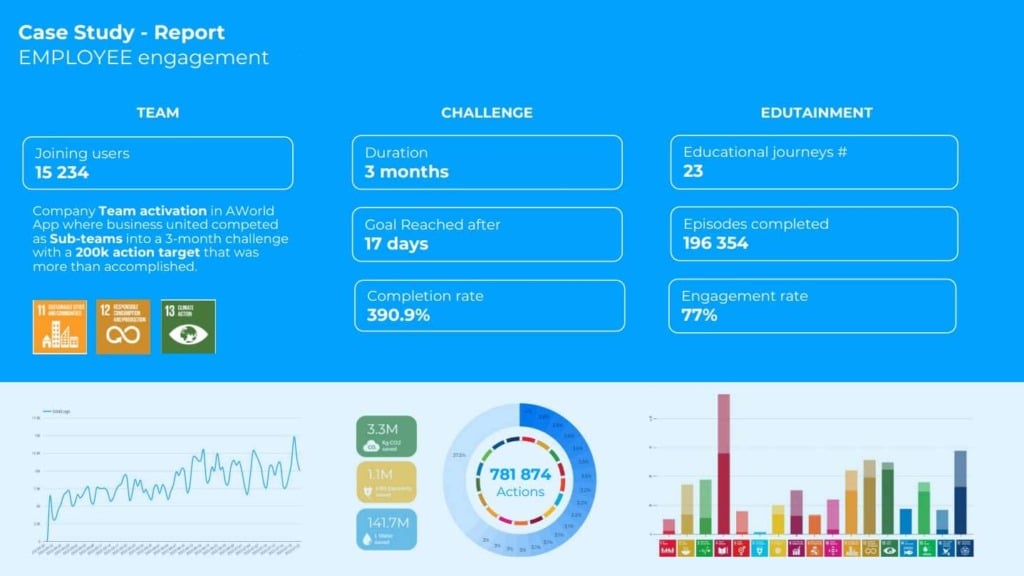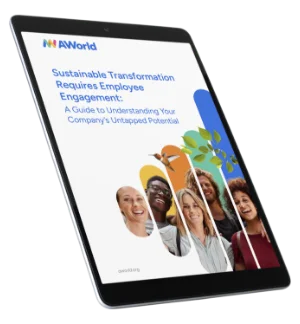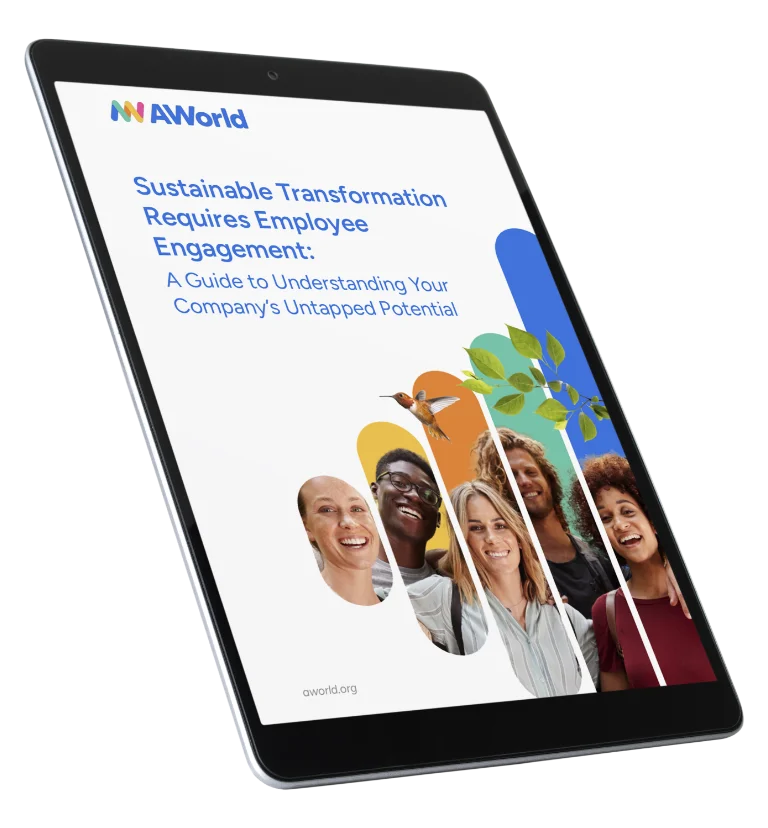Before we embark on this journey, let’s explore the concept of employee engagement in sustainability.
Employee engagement in sustainability goes beyond just participation—it encapsulates the wholehearted involvement, unwavering commitment, and active contribution of employees in sustainable practices within an organization. It entails seamlessly integrating sustainability principles and initiatives into the very fabric of the workplace culture, while actively involving employees in environmental, social, and economic sustainability efforts.
We know that employees play a pivotal role in driving sustainable practices within an organization. By actively embracing their expertise, creativity, and unwavering dedication, organizations can cultivate a thriving culture of sustainability. Through collaborative efforts, they can make significant strides toward achieving meaningful progress in environmental preservation and social well-being.
While the significance of sustainability for organizations is increasingly acknowledged, many still grapple with the challenge of effectively engaging every single employee in their day-to-day sustainability endeavours. It is imperative to find innovative approaches that inspire and empower individuals across all levels of the organization, fostering a shared commitment towards sustainability.
Now, the question arises: How can your organization successfully engage its employees on this transformative sustainability journey?
Table of Contents
- Unlocking the power: 8 proven methods to boost employee engagement in sustainability
- Embrace a long-term purpose
- Highlight the economic case for sustainability
- Foster sustainability knowledge and competence
- Inspire every employee to be a sustainability champion
- Engage in co-creation with employees
- Cultivate healthy competition
- Make sustainability visible inside and outside the company
- Showcase transformational change and a higher purpose
- Cracking the code of employee engagement: unveiling the 4 Es formula
- Employee engagement: a game-changer for the ESG balance sheet
- Embracing sustainability champions: unleashing the power of employee engagement for a greener future
- Conclusion
Unlocking the power: 8 proven methods to boost employee engagement in sustainability
Paul Polman, the esteemed CEO of Unilever, shared valuable insights in a 2016 article published in the Stanford Social Innovation Review. His wisdom encompasses eight practical ways to engage employees in daily sustainability activities and build a lasting sustainable organization. Let’s explore these strategies:
Embrace a long-term purpose
Infuse a clear and compelling long-term purpose into your organization’s business strategy. When employees connect with a higher sense of purpose, it cultivates a work environment filled with meaning and fulfilment.
Highlight the economic case for sustainability
Demonstrate the financial benefits of sustainability initiatives. Assess how each sustainable initiative contributes to your company’s profitability. When employees witness the positive impact of sustainability on the organization’s success, they become more engaged in their own roles
Foster sustainability knowledge and competence
Empower your employees with the necessary training and resources to understand and champion sustainability. Cultivating a culture of sustainability requires providing the knowledge and skills that enable employees to actively support your organization’s sustainability initiatives.
Inspire every employee to be a sustainability champion
Embed the principles of sustainability at every level of your organization through engagement programs. From the CEO to entry-level employees, instil a shared commitment to sustainable practices. This inclusive approach fosters genuine sustainability and ensures that everyone contributes to its success.
Engage in co-creation with employees
Invite employees to participate in the development of your organization’s sustainability program. When employees have a voice and can actively contribute to shaping sustainability initiatives, their commitment and dedication soar.
Cultivate healthy competition
Harness the power of friendly competition to drive employee engagement in sustainability. By introducing contests, challenges, or rewards, you can ignite a sense of excitement and motivation, encouraging employees to actively participate in and contribute to your company’s sustainability goals.
Make sustainability visible inside and outside the company
To foster a culture of sustainability, it is vital to ensure its visibility. Communicate sustainability initiatives to employees, keep them informed about progress, and celebrate achievements. External communication can also raise awareness and demonstrate your organization’s commitment to sustainability.
Showcase transformational change and a higher purpose
Expand your organization’s purpose beyond internal gains and align it with societal challenges. By aspiring to create meaningful and impactful change in the world, you inspire employees to connect with a higher purpose and contribute to a positive difference in the lives of individuals and communities.
By implementing these strategies, your organization can ignite a powerful wave of employee engagement in sustainability, driving meaningful progress and fostering a sustainable future.
Cracking the code of employee engagement: unveiling the 4 Es formula
The 4 Es model of employee engagement offers a theoretical framework that identifies four key elements: enablement, energy, empowerment, and encouragement. These elements collectively shape a thriving workplace where employees are truly engaged and motivated. Let’s explore each element in more detail:
- Enablement revolves around equipping employees with the necessary resources and removing any barriers that impede their progress. By addressing individual needs and concerns, organizations enable their workforce to perform their job responsibilities effectively and efficiently. Supporting employees in their work fosters a sense of empowerment and ensures they have the tools they need to excel.
- Energy may seem like an individual trait, but it is greatly influenced by the work environment. Organizations that prioritize employee well-being and provide support for managing physical, emotional, mental, and even spiritual energy witness remarkable improvements in employee engagement. Creating a positive work environment that energizes employees contributes to their overall satisfaction and commitment to their roles.
- Empowerment lies at the heart of long-term engagement. It involves transferring the power to achieve results from managers to employees, granting them autonomy and decision-making authority. When individuals are empowered to make choices and act without constant permission-seeking, they become fully invested in their work, delivering on their commitments with passion and accountability.
- Encouragement is often overlooked or relegated to urgent situations, but it holds tremendous influence in shaping employee engagement. A simple word of support or unexpected recognition can have a profound impact on motivation and morale. When encouragement becomes a consistent practice, it establishes a foundation of confidence and resilience, supporting employees consistently throughout their journey.
By embracing the principles of enablement, energy, empowerment, and encouragement, organizations can unlock the true potential of their workforce, cultivating a culture of engagement and achievement.
Recognizing and nurturing these key elements fosters an environment where employees thrive, contribute their best, and feel valued in their professional journey.
Employee engagement: a game-changer for the ESG balance sheet
Employee engagement is typically not explicitly listed as a separate component on the ESG (Environmental, Social, and Governance) balance sheet. The primary focus of the ESG balance sheet is to evaluate a company’s performance and impact concerning environmental, social, and governance factors. While employee engagement is a vital aspect of the social component, it is generally evaluated using other metrics and indicators rather than being directly incorporated into the balance sheet.
However, it is important to recognize that employee engagement can indirectly contribute to a company’s overall ESG performance. When employees are engaged, they are more likely to demonstrate commitment to the company’s mission, values, and sustainability initiatives. They become motivated to actively contribute to positive social impacts, such as promoting workplace diversity and inclusion, prioritizing employee well-being, and engaging with the local community. These factors can have a profound influence on the social aspect of a company’s ESG performance, ultimately enhancing its overall sustainability profile.
Embracing sustainability champions: unleashing the power of employee engagement for a greener future
Engaging employees in sustainability is not only crucial for environmental protection but also fosters a sense of responsibility, awareness, and collective action among the workforce. By involving employees in environmental initiatives, organizations can make a substantial contribution to addressing environmental challenges and working towards a more sustainable future.
One effective approach to engage employees in sustainability is through the use of games and challenges. These initiatives can serve multiple purposes, including promoting awareness and providing training on sustainable issues, as well as encouraging employees to adopt sustainable habits and practices within the workplace. Examples include waste reduction, energy conservation, water management, sustainable mobility, and recycling. By incorporating these activities into employees’ daily routines, organizations can not only minimize their own environmental impact but also contribute to the protection of the environment and the planet.
Sustainability apps like AWorld can play a significant role in engaging employees in sustainable practices. These apps enhance awareness, track progress, and make sustainability efforts more interactive and enjoyable through goal-based challenges and games.
AWorld allows organizations to set up games and challenges among employees, allowing them to define their own goals to be achieved. The app primarily measures progress through indicators such as CO2 emissions, water usage, and electricity savings. Upon completion of the challenges, AWorld provides a comprehensive qualitative and quantitative report on the activities undertaken, including:
- The number of participants involved
- Engagement rate
- Total number of actions logged and resulting savings
- Overall CO2, water, and energy savings
- Time spent on the educational course
- Alignment with Sustainable Development Goals (SDGs) and targets
- CO2 footprint
By utilizing a solution for employees’ engagement like AWorld, organizations can effectively engage their workforce in sustainable practices, track their efforts, and showcase their positive impact on both a personal and organizational level.

Conclusion
In conclusion, employee engagement in sustainability is a pivotal factor in propelling sustainable practices within organizations. By actively involving employees, organizations can cultivate a culture of sustainability and make significant strides towards environmental and social objectives.
To achieve this, organizations can harness the power of innovative tools like eco-friendly apps, like AWorld. These apps utilize a combination of data, education, gamification, and behavioral sciences to empower every employee to become a frontline champion in the battle against climate change. By leveraging these tools, organizations can create a dynamic and engaging platform that motivates employees to take meaningful actions and contribute to a more sustainable future.






